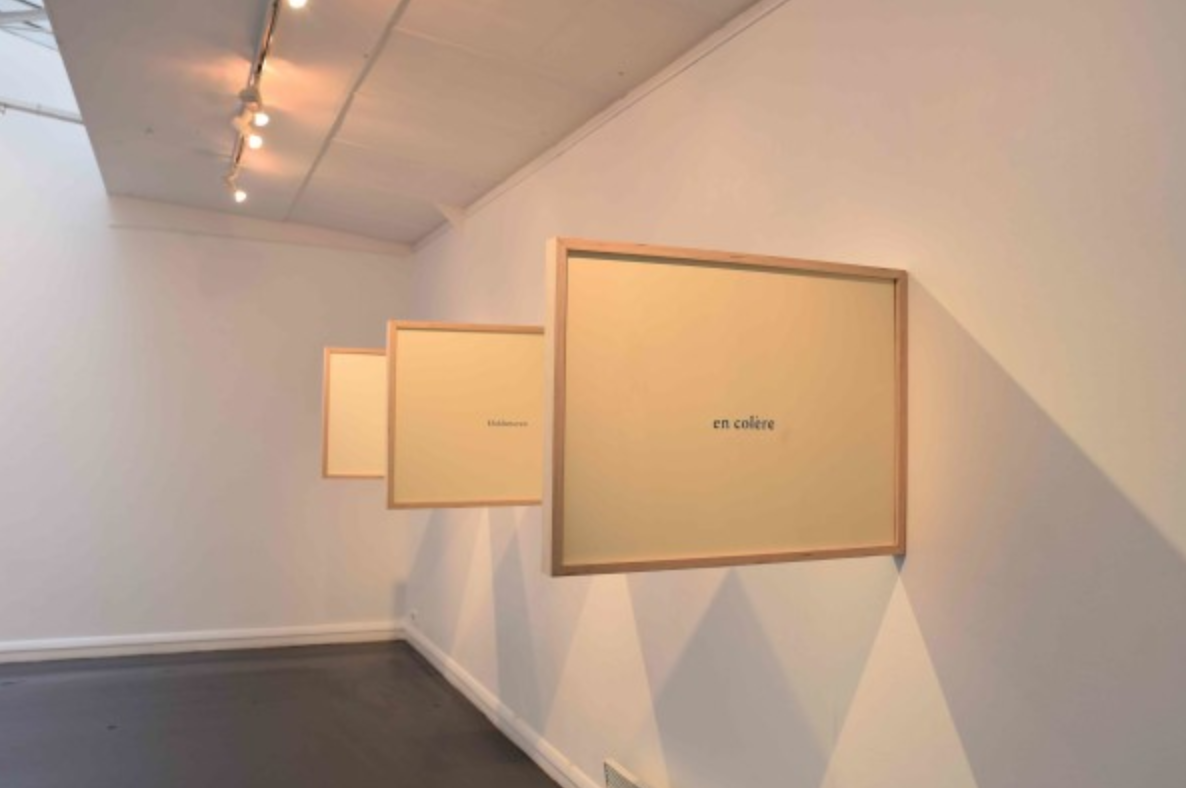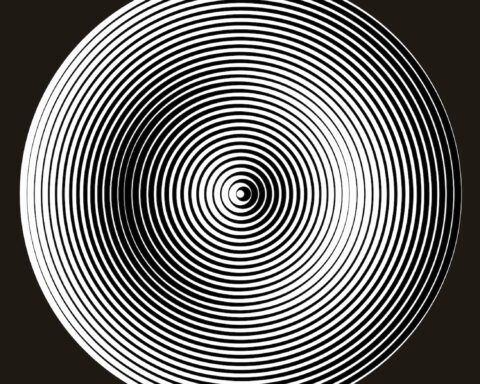Adrien van Melle, born in 1987, is a visual artist, photographer and writer based in Paris. The study of identity, representation and time is at the center of his interests. In order to ensure this, Adrien carries out a self-referential investigation, between the fictional narrative and the autobiography, interweaving different disciplines and supports. As much in his installations as in his writings, he immerses the viewer / reader in a literary universe that is both atopic and familiar, which is about to be (re-)invented as many times as history and imagination allow it.
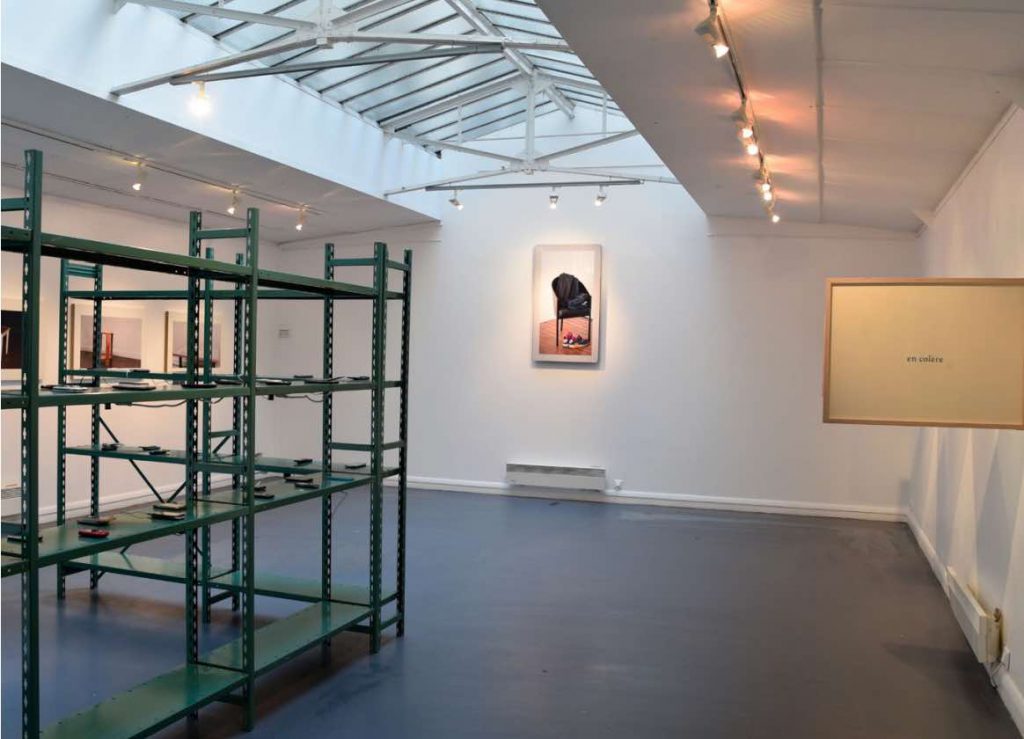
(From left to right) Téléphones, étagères, Adam, Gabriel et Jules, 2019 Chaise, 2019 STAAT / ÉTAT (œuvre de Jules Wouters), 2019 Photo Mélodie Lapostolle
Coral Nieto: I wonder about the way you use fictional characters (Adam, Gabriel and Jules in particular). Where do these “minor stories”, as Gilles Deleuze and Félix Guattari theorize it, lead you?
Adrien van Melle: This is a question that raises some interesting points related to my practice. If we refer to Deleuze and Guattari’s definition of a minor language, this is the writing that a minority makes in a major language. I don’t feel like I belong to a minority, I am a man, white, I live and was born in the capital of my country. However, I am sometimes an artist, sometimes a writer, often both, but I do not feel I have the status of a writer, the one with a capital “W”, this fantasized status that includes the gift of not making spelling mistakes, to handle language – and even languages, theoretical, administrative, literary, oral, with dexterity. I don’t feel like I am the bearer of authority with regard to French. Is it because I was a pretty bad student until high school, that mild dyslexia and impaired concentration always made teaching spelling and grammar a nightmare for me?
Should I also delve into my strong interest, which shines through in my work, for my Sephardic family origins on one side and Flemish on the other, to explain a certain form of deterritorialization? It’s possible, but I’m ultimately in a bad enough position to judge. Regardless, I feel that writing is both an absolute necessity in my work and something that I practice instinctively. My attraction to the everyday, the banal, as well as my “transparent writing” (this time to use Barthes’s term) bring a form of universality to my work, which involves the very particular. My primary research is ultimately the presence of an emotion, almost poetic, through the recognition of a certain daily life, of characters that are both stereotypical and with blurred outlines.
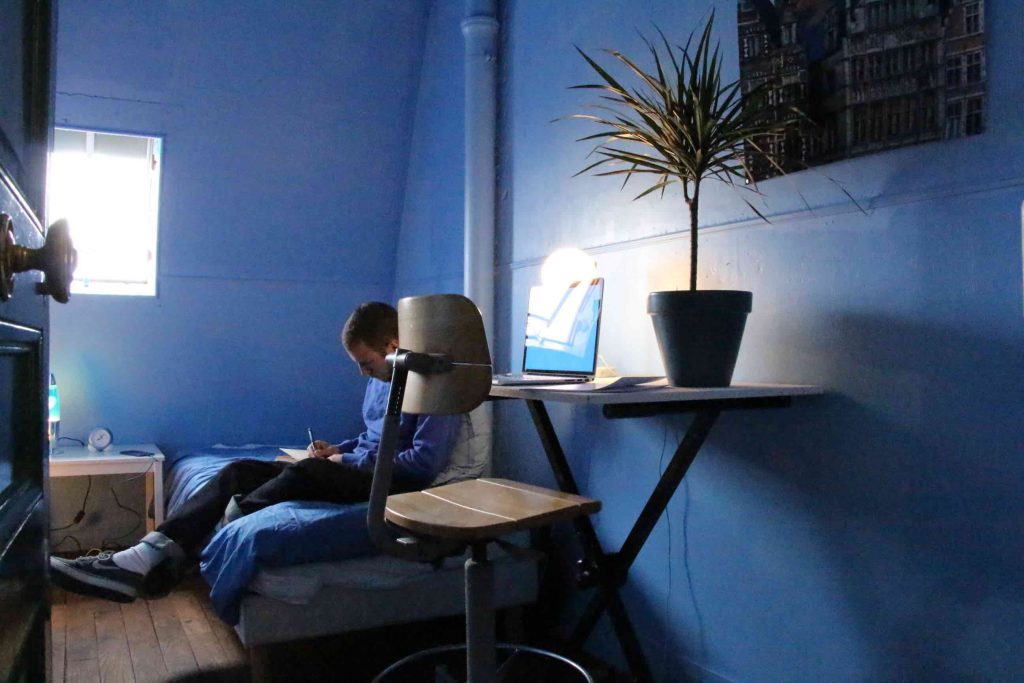
C.N. How do you work with fiction (symbolism) in communion with documentation? Could we speak in terms of “anthropological inquiry” when you produce these stories?
A.M. I research a lot. Sometimes I need to see the places I’m writing about. I have to know the objects I am describing, I don’t invent so much. However, I have the feeling that what makes the essence of my stories, namely the micro-feelings, the sensations, even the actions of the characters and the narrative context, it always comes from me. It’s very rare that I shoot a character outside of a mirror effect, that’s probably why Adam, Gabriel and Jules are all three artists, all three men, white, etc.
I think that talking about anthropological investigation is half right, reality plays a very important part, a certain form of materialism too, of attachment to the tangible, but the subjective and the fiction are the main protagonists and it is in fact the effect of reality that I am going to seek. If there is an anthropological inquiry, it is an exploration of the condition of the artist through the observation of internal micro-events, rather than through a methodical, scientific and objective study of reality.
I very clearly started from a work of autofiction, which was a big part of my Beaux-Arts production, and slowly moved towards something more fictional. I feel like I’m still in this transition.
C.N. Why is there a need for the plural (Adam, Gabriel, Jules) if you start from questioning about yourself? Is this narrative multiplicity imposed by the choice of aesthetic or moral issues? Does it involve a process of defamiliarization in the heart of your work?
A.M. I started working on this fiction a few months or weeks after I graduated from Beaux-Arts in 2017. At that point, I say the idea was to stay in a form of autofiction and apply a kaleidoscopic effect that would allow me to go search in different places while keeping a narrative continuity, because I already had the idea of creating a long-term fiction, exploded in various artistic mediums.
Now I think it responds to the need to move away, not from me, because I can’t do it right now, but from my reality. This is indeed what happened and if the main subject of the narratives remains a form of everyday life and an interest in the mundane, the characters are beginning to free themselves, to follow various trajectories.
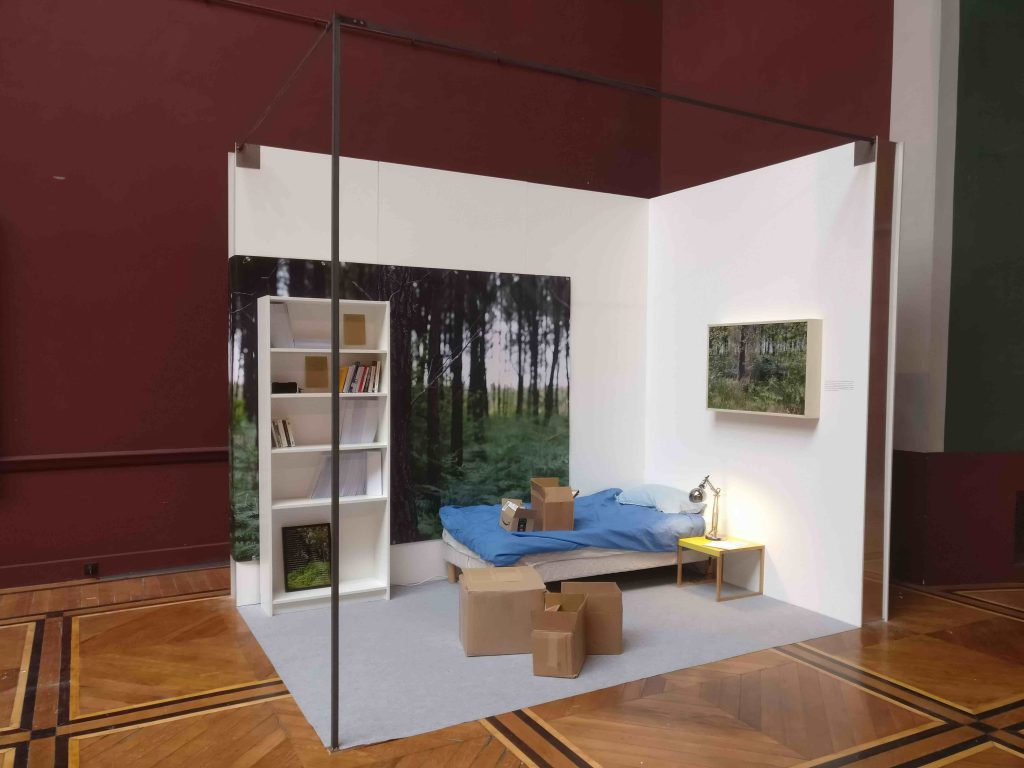
C.N. Why the choice of different supports (the object, the written track, the photograph, the sound…)? Do you intend the conception of a work capable of mixing different intersemiotic universes through the mixing of writings and temporalities?
A.M. I believe that is already the case in some instances. In Téléphones, étagères, Adam, Gabriel and Jules (2019) for example. It is an installation consisting of six metal shelves on which are arranged sixty mobile phones. All are permanently lit up and each displays a different text, relating to the narrative sphere of one of the three characters. Sometimes it is a text in a fairly classic literary form, written in the simple past tense, in the third person, in prose, and at other times a word, an SMS that can be read on the Messages application on the smartphone. The stories get mixed up and it becomes difficult for the viewer to reference the “micro narrations”. Despite their formal uniformity, the nature of these phone objects varies, since some smartphones are truly display devices in terms of the type of text displayed and the way in which it is displayed, while others could be qualified as “fictional objects”, as if they had been extracted from the narrative universe, for example when they display text messages, a note written on a calendar, etc.
As for the choice of media, I am not sure that it is one. I started, after high school, by studying cinema at the Sorbonne for four years, before moving on to photography at the Louis-Lumière School and finally, I entered the Beaux-Arts. I realized after a few experiences that cinema was not for me, too many constraints, too long production times, the obligation to work in groups. This is what made me go to photography, then to Fine Arts. Now, I use the mediums that I find most suitable for each project, each narration. I often have the fantasy of being a more formal artist, of being able to spend time producing more successful forms, working on a technique, but it’s really the opposite of my way of producing.
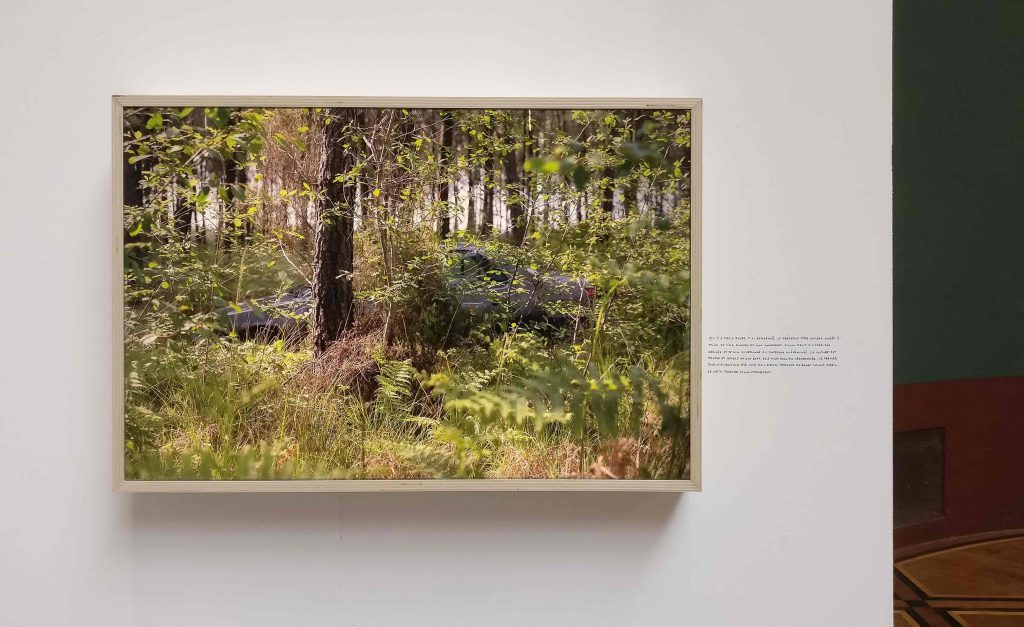
C.N. After having closely studied your practice, it seems to me that you use fiction as a tool to relate to reality? How would you qualify these spaces “between” (between fiction and reality) to which the spectators are led?
A.M. It seems to me that fiction allows a much finer and more accurate connection with reality, in terms of feelings and sensations. It’s a pretty personal and instinctive belief that I think is linked to my very subjective view of reality. Which seems to me more in accordance with my way of feeling it after being passed through a filter. In this sense, I remember my first and powerful artistic emotions around eighteen when I discovered the cinema of Eric Rohmer and that of Wim Wenders. Alice dans les villes and Lisbonne Story are references for me that I keep in mind almost at the beginning of every project.
What is quite clear, however, is that the real is my work tool. I can’t imagine delving into a story where the setting, the details, are completely the fruit of my imagination. This also applies to the plastic part of my work. My drawings are almost exclusively working where I put myself in the position of a transcriber, I reproduce and redraw existing objects, sometimes photographs.
I like to play with the spectator, not to play with him, but to invite him to play. Suggest him to enter into an immersive and realistic narration while revealing to him, at the same time, that it is a construction. It is this mechanism that I use in several of my installations, in which I reproduce the life pieces of my characters.
C.N. During the installation of the produced stories, that means, during the staging of all these literary and extra-literary elements, how do you combine them to ensure that the literary spectrum is always the key element?
A.M. The narrative part is indeed, in my opinion, the major and endemic element in my work. However, it happens that I start the production of a new work, a new installation, with a formal desire, even if this is very quickly completed by a narrative project.
Today we are used to seeing the mediums specific to the visual arts mixing together. No one is surprised when a painter places his canvases in space in order to flirt with the idea of the installation, or a photographer takes pictures of sculptures he has made that will not have another destiny than to be seen through his camera. On the other hand, the introduction of literature is at the same time rarer, more difficult, and effectively leaves behind a vestige, a wake, which one could qualify as spectral.
Obviously, I play from this statement, and I like the idea of forcing the viewer to become a reader before they step back into the viewer role. Thus, I encourage moving away from a passive position to an active position, from public to private, from visible to intimate.
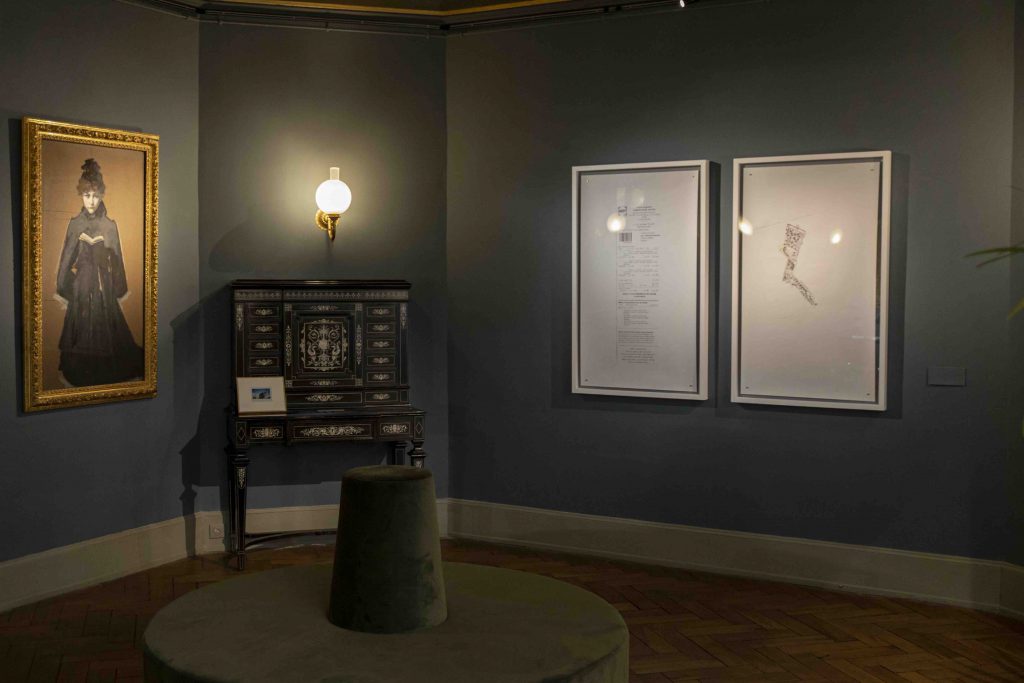
C.N. Do you think that the idea of adding an audible device would add another dimension to the questioning of identity? If so, which?
A.M. This is something that I have done many times. I produced a sound piece in 2017, a dialogue between two characters that seemed to me to require placing the viewer in a listening posture without giving them visual keys. However, I am (perhaps for now) relatively reluctant to give a “soundtrack” to my installations or exhibitions. I think I like, as a viewer, that immersivity is offered to me but not imposed. That it takes some effort. So that’s what I try to do in my work.
C.N. Self-objectification through autofiction finds its heritage in the wake of avant-garde experiences. A great example is André Breton’s novel Nadja (1928), where the “I” acquires multiple functions at the same time as it reveals an identity split. What is your position in response to the identity issue of our time? What tools are you using to identify this point?
A.M. This is a difficult question. On this point, I operate very instinctively. I am more comfortable with the analysis of structures and situations than with that of individuals. In addition, I am a very reserved person and I admit being regularly uncomfortable and finding the emphasis on individual identity unreadable. I’m mainly referring here to social media and a form of self-promotion of one’s image.
The other major current identity issue seems to me to be the representation of minorities. Being a man and not belonging to a visible minority, I don’t feel like I have to fight a personal battle on this front. So, I have more of a position of interested and receptive spectator, because I believe that it is not (or no longer) the artist’s place to lead struggles for others.
By contrast, I think that we are confronted, I am speaking here of the society that I know, that is to say Western and predominantly Judeo-Christian, at a time of collapse (and perhaps of restructuring, I hope) values. It seems to me to be rather a good thing, whether it is on bourgeois or religious values or better still that of unbridled consumption. Still, we found ourselves helpless, aimless, maybe a little too focused on ourselves, lonely. This is what I believe that I’m trying to talk about in my stories.
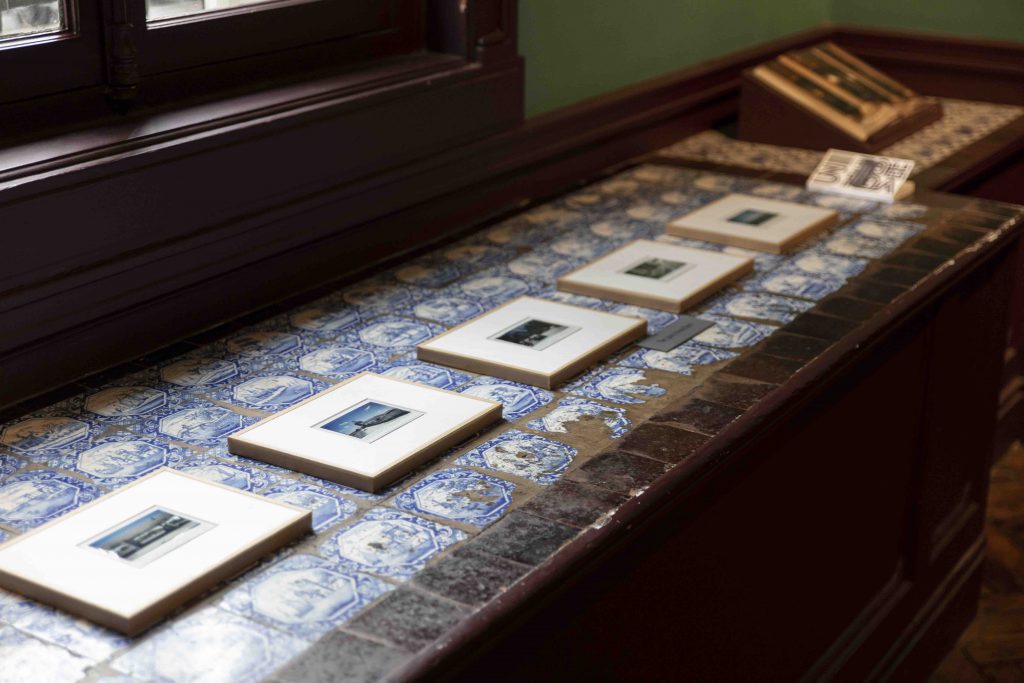
C.N. What do you think about the fate (circulation, reception) of your writings?
A.M. In addition to my activity as an artist-author, I am also an editor and I take care of an artist-run-space. So, I have a fairly precise vision of how the small printing book industry works and how it is distributed. I have just finished an artist’s book, linked to my exhibition at the Jean-Jacques Henner Museum, which borders are on the novel and the exhibition catalog, and whose publication is a collaboration between the museum and my publishing house. I know, for example, that if this book is sold in 300 copies it will be a real success. Many of my writings are related to exhibitions or plastic works and, while they are accessible outside and after the time of the exhibition, I have no illusions about their scope in terms of circulation. I don’t care much about the broadcast right now, and I don’t think a lot about spreading after finishing a project, I’m usually anxious to tackle the next one quickly, excited for the novelty. Of course, that does not prevent me from having in the back of my mind the fantasy of publishing a novel with a publishing house with national scope, and a compendium of texts related to Adam, Gabriel and Jules.


